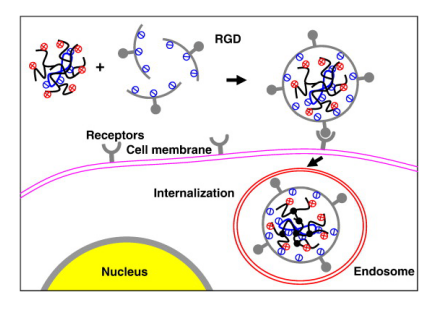Active targeting employs some strong interactions such as ligand-receptor or other molecular recognition to confer more specificity to the delivery system. The most important challenge in active targeting is to define the most suitable targeting agents to selectively and successfully transport nanoparticle systems to target tissue thus avoiding any kind of toxicity in the process. Peptides or receptor-ligands are used for targeting drugs to their specific receptors that are expressed profusely in different states of the disease.
Peptides or receptor-ligands have shown great potential in terms of targeting for delivering various chemotherapeutic agents. Peptides could be natural or synthetic, short polymer chain compound, containing two or more amino acids linked by the carboxyl group of one amino acid to the amino group of another. The activity of anticancer drugs can be enhanced by coupling targeting moieties to the surface of nanoparticles to promote selective binding to tumor-associated antigens and facilitate the drug delivery to the intended cellular sites. These ligands are very cost-effective and easier to synthesize and conjugate. In addition, peptides or receptor-ligands are in small size which is easy to attach multiple molecules onto each nanoparticle surface. They not only target the specific surface receptors but can also penetrate into cells or tissues to cause cell toxicity. Together with its advantages which are smaller, less immunogenic molecules, and easier to produce and manipulate, it also could be combined with improved screening techniques to isolate ligand-substrate combinations that have contributed to the increased role of peptides as targeting moieties in the past decade. These peptides or receptor-ligands targeted nanoparticles exhibited extensive localization in the tumors after crossing the blood-brain barrier, as compared to the non-targeted nanoparticles which showed some preferential localization due to the Enhanced Permeability and Retention effect (EPR).
These molecules are conjugated with nanoparticles through covalent bonds by a variety of linkages, peptide bond, sulfanyl bond, disulfide bond and so on. Various peptides such as RGD, Angiopep-2, Tat, Tet 1 and PR_b have been used for targeted delivery of nanoparticles for different applications including therapy and diagnostic imaging. The most widely investigated peptide ligand is probably the RGD (arginine–glycine–aspartic acid) peptide family, which can strongly and specifically bind to αvβ3 integrin receptors highly expressed on tumor cells. Another such protein known as low density lipoprotein receptor-related protein (LRP) that is highly over expressed by the blood-brain barrier and glioblastoma multiforme, a tumor of the pituitary gland. Angiopep-2 is a complementary ligand which can be used for targeting purposes. The increasing use of peptides as targeting ligands has been aided by the use of phage display to identify novel ligands because phage-displayed random peptide libraries help to discover protein-protein contacts and identify bioactive peptides bound to receptors or proteins.

Figure 1. Schematic illustration of RGD-modified nanoparticles migrating through cell menbrane. (Tian H, et al. Journal of controlled release, 2011, 155(1), 47-53.)
CD Bioparticles is specialized in the development of drug targeting strategy and customizing nanoparticles for drug delivery and targeting utilizing our core technologies. With our high-quality products and services, we will use phage display to select from the peptide libraries and find the disease-specific antigens and cell- and organ-specific peptides for your project. Our experienced scientists are proficient in providing products or synthesis services of peptide or receptor-ligand as RGD, Angiopep-2, Tat, Tet 1, as well as conjugation service of ligands to nanoparticles according to your special needs. Polymer, liposome and magnetic particles, micelles and dendrimers and other types of particles are all candidates as nanocarrier materials to choose from.
Quotations and Ordering

References:
1. Steichen SD, Caldorera-Moore M, Peppas NA. A review of current nanoparticle and targeting moieties for the delivery of cancer therapeutics. European Journal of Pharmaceutical Sciences, 2013, 48(3), 416-27.
2. Bertrand N, Wu J, Xu X, Kamaly N, Farokhzad OC. Cancer nanotechnology: the impact of passive and active targeting in the era of modern cancer biology. Advanced drug delivery reviews, 2014, 66, 2-5.
3. Pawar, Prasad V., Abraham J. Domb, and Neeraj Kumar. Systemic Targeting Systems-EPR Effect, Ligand Targeting Systems. Focal Controlled Drug Delivery. Springer, Boston, MA, 2014, 61-91.
1. Download the template.
2. Enter product information on the template (maximum number of products: 200).
3. Load the file using selector below.
1. Download the template.
2. Enter product information on the template (maximum number of products: 200).
3. Load the file using selector below.